For this guide, we will focus only on barbell exercises, that will target the upper body musculature, namely- The chest, back, shoulders, biceps and triceps.
Now those of you that train using an upper/lower body split, know for a fact that using such a workout split doesn’t really let you include many exercises for each muscle group, like the conventional chest/bicep, back/triceps splits do.
However, that does not mean the gains will be any less, as the only thing that matters is the way you do the exercises. A split where you train your whole upper body in one day, followed by a lower body workout and a rest day, can be just as efficient as an ordinary 4-day workout split.
So, this barbell-focused workout includes about 5 working sets per muscle group. The exercises are in an antagonistic order, meaning that each exercise for a given muscle group is followed by an exercise for its opposing muscle group.
So, for example, the antagonist (opposing muscle group) of the chest, is the back, which requires pulling movements unlike the chest, that requires pushing movements. (The antagonist is always on the opposite side of the agonist and has opposite bio-mechanical requirements.)
The only muscle group that does not have an antagonist is the deltoids (shoulders). Another reason we have decided to place the exercises in such order is something we call “Active rest”. While training a certain muscle group, it receives contraction signals from the brain, and the opposing (antagonist) muscle group, receives relaxation signals.
So, for example, while training your biceps, your triceps receives relaxation signals from the brain, and vice versa- When you are training your triceps, the biceps get stretched out and actively recover during the triceps movement.
The workout
| Muscle group | Exercise | Number of sets | Number of Repetitions |
|---|---|---|---|
| Chest | Barbell bench press- Incline | 5 | 15,12,10,8,6 |
| Last set of 6 repetitions is done until failure. | |||
| Back | Barbell rows | 5 | 15,12,10,8,6 |
| Last set of 6 repetitions is done until failure. | |||
| Shoulders | Barbell standing military press | 4 | 10 |
| Biceps | Barbell curls | 4 | 10 |
| Triceps | Skull crushers | 4 | 10 |
Warm up
It is very important to prepare your body before each workout, so that you can get the best out of it. During the pre-workout warm up, include light cardio, along with stretching exercises.
Barbell bench press- Incline
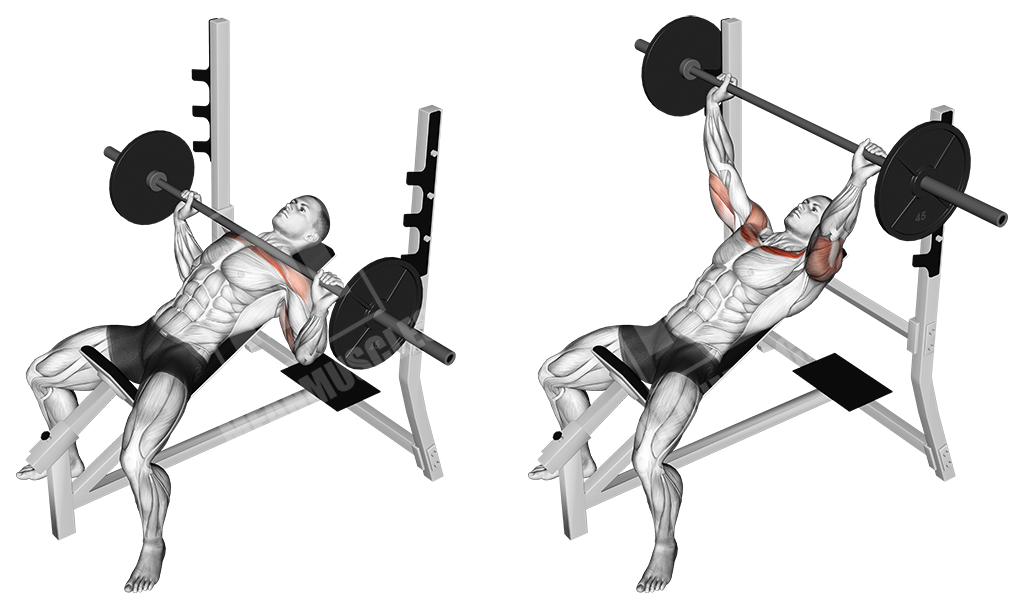

This is the first exercise in the routine. In this routine, the focus is on the upper chest (incline bench), as this is the sector of the pectoral musculature which most people struggle with.
However, if you happen to have a developed upper chest and an underdeveloped middle/lower portions, you can do flat/decline bench instead. As we said, this exercise is mainly used to target the upper chest, but also secondarily involves the triceps and shoulders musculature.
Before jumping into heavy weights, it is very important to continue your warm up throughout the first two (15,12 repetition) sets, so that your musculature will be completely ready for higher intensity. These first two warm-up sets are done with 25~35% of your maximum strength capabilities.
Once you are done with the first two sets, you can proceed to the last 3 (10,8,6 repetition) sets, which are done with progressively higher weights, starting from 70% of your maximum strength capabilities and ending with a set until failure (6 reps) using 80-85% of your maximum strength capabilities.
So, for example if your maximum strength capabilities (weight that you can lift once until failure) are 100 kilograms (100 kg 1 rep max) the first two warm up sets will be done with 25-35 kilograms respectively, and the working sets will be done with 70, 80 and 85 kilograms respectively.
Execution
- Lay down on the incline bench, with your legs stably on the ground
- Grab the bar wider than shoulder width. If you are a taller person, you can use a very wide grip- This will reduce the range of motion and will help you put focus on the chest
- Unrack the bar
- Keep elbows slightly bent- Do NOT lock them out. This will allow you to maintain constant tension on the pectoral musculature
- DO NOT lift your head off of the bench- This is a MUST! Lifting your head off of the bench may lead to excessive neck tension
- Let the bar go down slowly until it slightly touches your upper portion of the chest- DO NOT let the bar rest on your chest and DO NOT bounce it in the lower part of the movement
- Push up explosively to the initial position
Barbell bent over rows
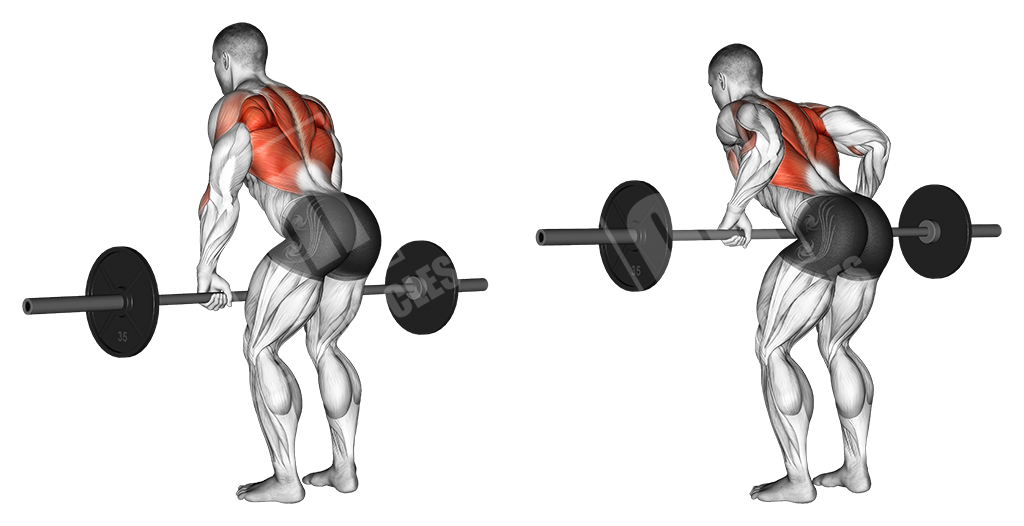

This second exercise targets the antagonist of the chest musculature, namely, the back. As the first exercise does not include any pulling movements, it is recommended to go through 2 warm up sets of 15 and 12 repetitions before jumping into the heavy working sets.
Execution
- Place the bar on the rack and load it
- Unrack the barbell
- Keep your knees slightly bent to maintain good balance
- Bend over so that your body is at a 45-Degree angle
- Keep your back straight
- Pull the barbell up explosively, contracting the back musculature and hold the contraction for a split second
- Let the barbell go down slowly to the initial, bent-over position
- Stretch out the back at the bottom and proceed to the next repetition
Barbell standing military press
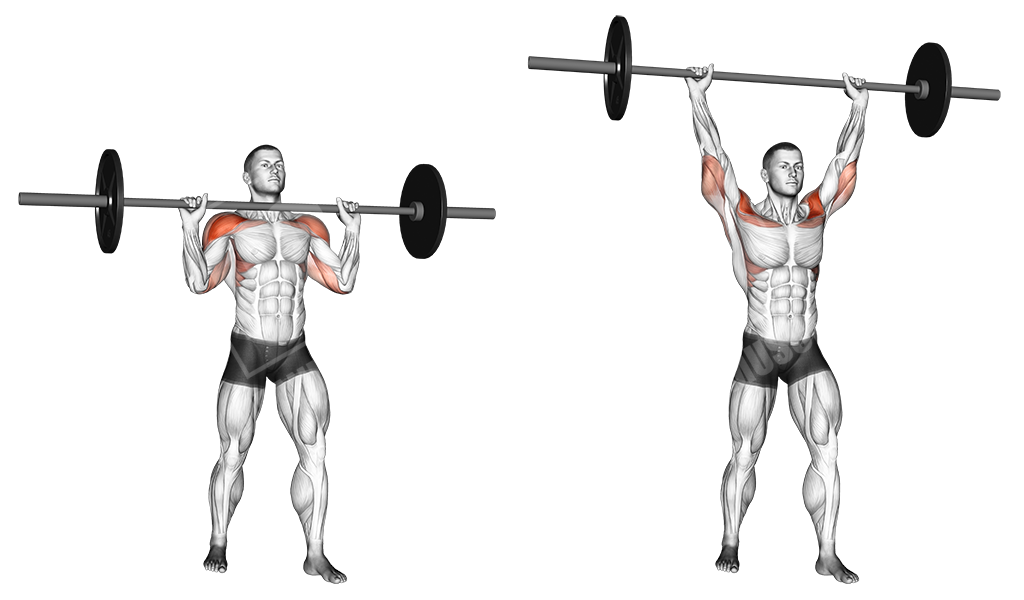

Now that you have gone through the first two exercises, that involve pushing and pulling movements, you are ready to proceed with heavier weights from the first set of the following exercises. No warm up of 15,12 repetitions is required, as the shoulder musculature is already warmed up from the previous exercises.
However, to avoid injury, start off from a lower intensity (~65%) in your first set of this exercise, and proceed to higher (~75%) intensity in the following sets, ending with a final, fourth set until failure.
Execution
- Stand up straight and unrack the bar so that it is at shoulder level as illustrated- Place your legs comfortably so that you have balance
- Place your hands at shoulder width, or slightly wider
- Push the bar up and above your head, contracting the deltoids
- Let the bar come down to the initial position
- Proceed to the next repetition
Note
If you feel pain in the shoulders, do not let the bar go completely down. Instead, let it go down until it reaches nose/chin level.
Barbell bicep curl
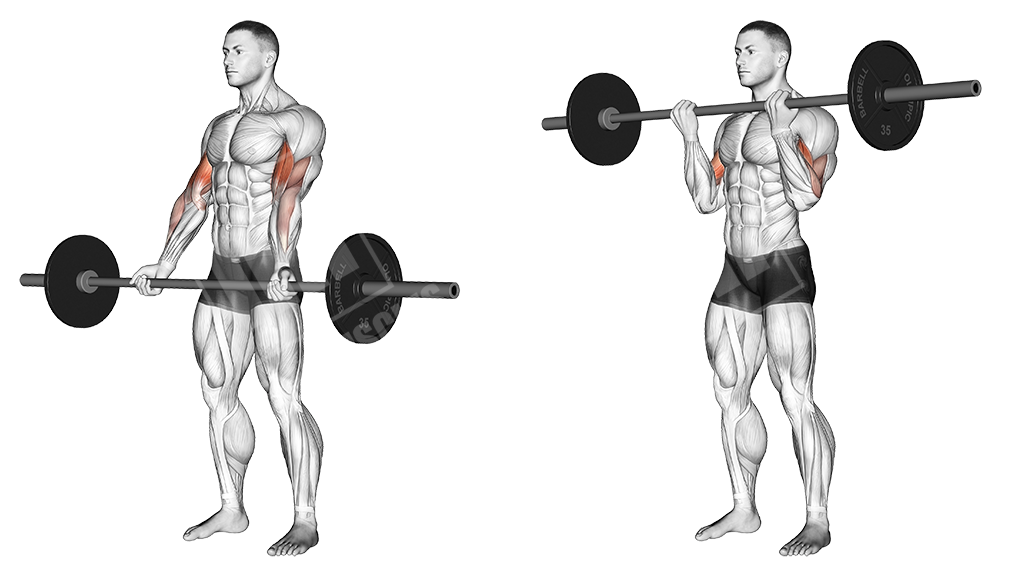

This third exercise involves the biceps and forearm musculature and is a basic bicep exercise.
Execution
- Stand up straight, grabbing the bar slightly wider than shoulder width
- Curl the bar up, until you reach maximum bicep contraction
- Hold the contraction for a split second
- Return to the original position
- Proceed to the next rep
Note
- Do NOT use swinging movements to help yourself on the way up. Instead, use an appropriate weight, which you can lift without the help of any inertial movements.
These inertial movements can be used as an aid to help you reach the point beyond failure AFTER you have completed the 10 repetitions with correct form and have reached the point where you cannot do another repetition properly.
Check out our cheating principle.
- The upper portion of the arm remains static, meaning only the forearm moves.
- Before the beginning of each repetition, you can flex and relax your triceps- This will give you the feeling of your whole arm being involved in the movement
EZ-Bar standing French press
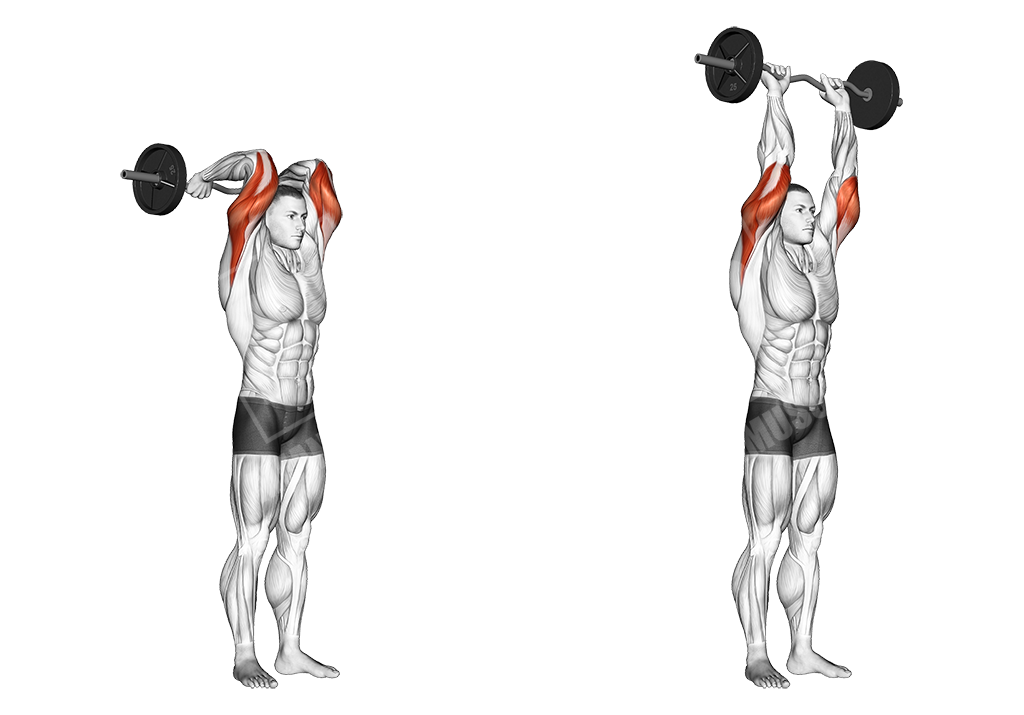

This final exercise targets the biceps’ antagonist- The triceps. It is done with an EZ-Bar, from a standing position.
Execution
- Stand up straight
- Grab the EZ bar and lift it up and over your head
- Let the bar go down and behind your head, until the point your forearms are parallel to the ground or slightly below that point
- Push up, slowly locking out the elbow to achieve greater triceps contraction
- Proceed to the next repetition
Important notes
- Do not open up your elbows, keep them closer to your head
- Keep your arms at a 90-degree angle and avoid swinging them
- DO NOT go below the given end-point, as letting the arms go all the way down will result in excessive triceps tendon stretch, which may lead to an injury.
- Do NOT go full-in and reach failure, as this may also lead to an injury
Conclusion
Unlike the conventional workouts, where you have one or two muscle groups per workout and multiple exercises for each of them, this workout focuses on heavy, compound movements, high intensity and sets until failure, which, combined with a proper nutritional intake, will inevitably lead to strength and muscle gains.
Check out our lower body barbell workout if you are getting into the upper/lower workout split and have trouble structuring your workouts.


